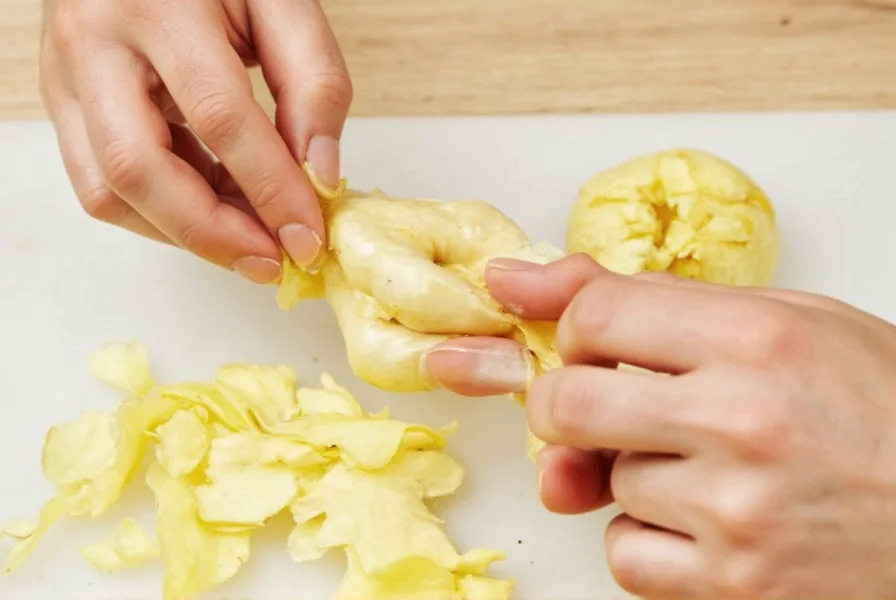Peeling ginger doesn't have to be a frustrating kitchen task that wastes precious spice. Many home cooks struggle with traditional peeling methods that either remove too much of the flavorful flesh or risk injury from slippery ginger and sharp knives. The truth is, ginger's irregular shape makes it uniquely challenging to peel with standard tools, but with the right technique, you can preserve maximum flavor while minimizing effort.
Why Ginger Peeling Requires Special Techniques
Ginger root has a thin, papery skin that's technically edible but often fibrous and unpleasant in finished dishes. Unlike potatoes or carrots with relatively smooth surfaces, ginger grows in irregular knobs and crevices that make conventional vegetable peelers inefficient. Most peelers remove too much flesh along with the skin, wasting up to 20% of your ginger. Understanding how to peel ginger properly ensures you maximize your ingredient while maintaining safety in the kitchen.
The Spoon Method: Professional Chefs' Preferred Technique
Using a spoon to peel ginger has become the gold standard among professional chefs and home cooks alike. This method works because the spoon's curved edge naturally follows ginger's contours, removing only the thin outer layer.

Step-by-Step Spoon Peeling Instructions
- Select a regular teaspoon (not a dessert spoon) with a smooth edge
- Hold the ginger firmly in one hand and the spoon in the other
- Position the edge of the spoon against the ginger skin at a 30-degree angle
- Gently scrape the spoon along the ginger's surface, following its natural curves
- Rotate the ginger as needed to reach all surfaces
- Rinse the peeled ginger under cool water to remove any remaining skin particles
This technique works exceptionally well for both young ginger with thinner skin and mature ginger with tougher exterior. The spoon method typically takes less than one minute for a standard ginger root and preserves nearly all the usable flesh.
Alternative Ginger Peeling Methods Compared
While the spoon method is generally superior, different situations might call for alternative approaches. Here's how various techniques stack up:
| Method | Best For | Waste Level | Speed | Safety |
|---|---|---|---|---|
| Spoon scraping | All ginger types | Lowest (5-10%) | Fast (30-60 sec) | Safest |
| Vegetable peeler | Smooth ginger sections | High (15-25%) | Moderate | Moderate |
| Knife peeling | Experienced users | Moderate (10-20%) | Slow | Riskier |
| Freezing method | Large batches | Low (5-15%) | Slow (requires thawing) | Safest |
Vegetable Peeler Method: When It Makes Sense
A standard Y-shaped vegetable peeler works reasonably well on ginger sections with relatively smooth surfaces. This method becomes less effective on the knobby parts where the peeler can't follow the contours. When using a peeler:
- Use short, controlled strokes rather than long pulls
- Apply minimal pressure to avoid removing too much flesh
- Rotate the ginger frequently to match the peeler to the surface
- Consider using the peeler only on the smoother sections and switching to a spoon for knobby areas
Knife Peeling: Traditional Approach with Safety Considerations
Some traditional cooks prefer using a paring knife to peel ginger. While this method gives you precise control, it requires more skill and carries higher risk of cuts, especially with ginger's slippery texture.
If you choose to use a knife:
- Use a small, sharp paring knife (dull knives are more dangerous)
- Peel away from your body at all times
- Work on a stable cutting board with a damp towel underneath
- Consider wearing a cut-resistant glove on your non-knife hand
- Only remove the minimal necessary skin - ginger doesn't require deep peeling
Freezing Method: Best for Large Quantities
For those who use ginger frequently, the freezing method offers an efficient solution for multiple roots. Simply place unpeeled ginger in the freezer. When frozen solid, the skin becomes brittle and can be easily scraped off with a spoon or even rubbed off with your fingers. This technique works particularly well for preserving ginger long-term while maintaining freshness.
Special Considerations for Different Ginger Types
Understanding how to peel ginger properly depends somewhat on the type you're working with:
- Young ginger: Has thinner, more delicate skin that's sometimes edible. Requires gentler handling as the flesh is more tender
- Mature ginger: Features thicker, tougher skin that definitely needs removal. The spoon method works exceptionally well here
- Preserved ginger: Often already peeled or requires different handling - check packaging instructions
Maximizing Your Ginger: What to Do With the Peel
Don't throw away your ginger peel! It contains valuable flavor and nutrients:
- Simmer peels in water to make ginger tea
- Add to vegetable stock for extra flavor dimension
- Dehydrate and grind into ginger powder
- Create infused oils by steeping in carrier oil
Common Ginger Peeling Mistakes to Avoid
Even experienced cooks sometimes make these errors when learning how to peel ginger properly:
- Using too much pressure: This removes valuable flesh along with the skin
- Peeling before washing: Always rinse ginger first to remove dirt
- Using inappropriate tools: Forks or graters damage the ginger
- Peeling too far in advance: Peeled ginger dries out quickly; prepare just before use
- Discarding all peel: As mentioned, ginger peel has culinary uses
Practical Tips for Working With Ginger
Once you've mastered how to peel ginger efficiently, these additional tips will enhance your experience:
- Store unpeeled ginger in a paper bag in the refrigerator crisper drawer
- Freeze peeled ginger in an airtight container for long-term storage
- Use a microplane grater for finely grated ginger in sauces and marinades
- When a recipe calls for "knob of ginger," this typically means 1-2 inches
- Fresh ginger loses potency over time - use within 2-3 weeks for best flavor










 浙公网安备
33010002000092号
浙公网安备
33010002000092号 浙B2-20120091-4
浙B2-20120091-4